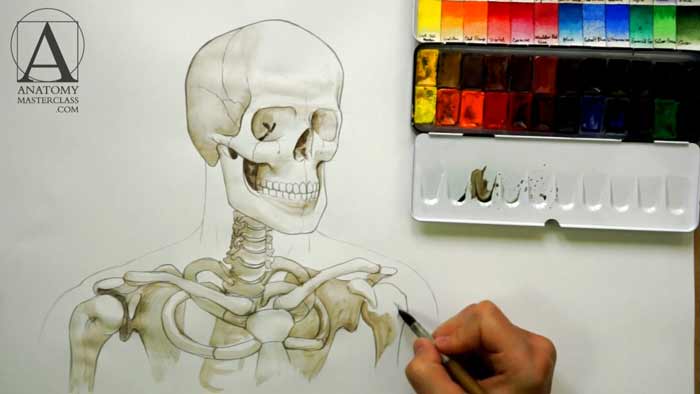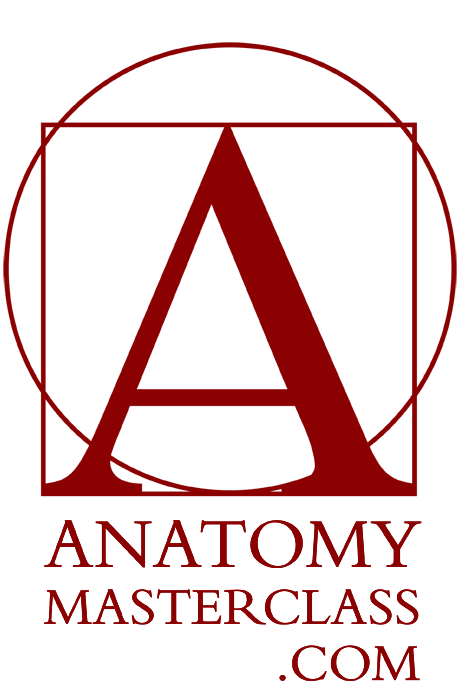Anatomy of the Head, Neck and Shoulders
Anatomy of the Head, Neck and Shoulders
Anatomy Lesson 6 – Part 2
In this video lesson, you will discover the Anatomy of the Head, Neck and Shoulders.
Bones of the skull
The skull consists of two major groups of bones – the cranium section and the bones of the face.
The cranium section is located above the red line on this drawing and the facial bones are below.
There are eight bones that form the cranium.
In the front, there is the frontal bone, which forms the forehead and upper walls of the eye sockets.

The sides of the cranium consist of two paired bones – the parietal bones and the temporal bones.
The parietal bone forms the upper side and a majority of the skull’s roof. The temporal bone covers the lower side and part of the skull’s floor.
Temporal bone also forms part of the zygomatic arch.
Another part of the temporal bone that is important is the mastoid process. This is the place behind the ear at the lower edge of the temporal bone, where several neck muscles attach to the skull. Knowing the location of this process will be very helpful in portrait drawing, as it is a good landmark in constructing correct proportions of the neck and head.
One more cranium bone visible here is the sphenoid bone. This bone is only partially visible here as it covers the cranium floor.
Facial Bones
Now, let us examine the bones of the face.
The maxilla bone covers the frontal part of the face. It forms the upper dental arch and is sometimes called the upper jaw bone.
This bone travels upward to the bridge of the nose and also forms the roof of the mouth.
The top part of the nose is formed by the pair of nasal bones. They form the bridge of the nose.
The front part of the zygomatic arch consists of the zygomatic bone. The top portion of this bone goes into the temple line – the line which separates the plane of the forehead and the side of the skull. It is an important landmark for a portrait artist to know and depict because its individual appearance influences the shape of the head.
The only movable bone of the skull is the lower jaw or mandible.
Bones of the Neck
The neck consists of seven neck bones. The neck section of the spine is called the cervical vertebrae of the neck.
Did you know that not only humans have seven neck vertebrae? Many other animals also have the same number, even giraffes (despite the fact that their necks are very long).
The first vertebra is called the atlas because it supports the sphere of the skull. This name originates from Greek mythology (a Titan was believed to hold the heavens on his shoulders).
The atlas’ shape allows nodding movements when a person indicates “yes” by ones head.
The second vertebrae is called axis. This name comes from the function of this vertebrae that allows rotation of the head (for example, when a person gesticulates “no” by shaking their head from side to side).
The seventh vertebrae is an important landmark for a portrait artist. This neck-bone possesses a longer spinous process, which is visible at the base of the neck as a bump and indicates the end of the neck and beginning of the ribcage.
Arm and Shoulder Bones
The upper arm bone, called the humerus, is connected to the body via the shoulder blade, which possesses the Latin name scapula.
At the shoulder joint, the round head of humerus is located inside of the socket that is fixed to the glenoid fossa of the shoulder blade.
Another part of the shoulder blade you must be aware of is the coracoids process. This is where important muscles attach to the shoulder blade; we will examine shoulder muscles in the next video section.
The outer edge of the shoulder blade is formed by the acromion. This is the place where the collarbone, called clavicle, joints the shoulder blade.
At the inner side, the collarbone is attached to the breastbone called the sternum. The top part of this bone is called the manubrium of sternum.
The first pair of ribs resembles an almost circular shape and forms the base of the neck as many neck muscles attach to the first ribs.
At the front, ribs attach to the breastbone via the costal cartilage of ribs, which is more flexible than bony ribs.
[ The full lesson is avaibale to Anatomy Master Class members ]
To learn more about the Anatomy of the Head, Neck and Shoulders, enrol in the Anatomy Master Class
Simple Pricing, No Surprises
One-time payment - Only $97 USD
ENROLL NOW



